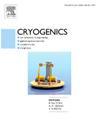Magnetic properties of Ni-Cu-Zn ferrite nanoparticles at cryogenic temperature probed under Mössbauer and VSM studies
IF 1.8
3区 工程技术
Q3 PHYSICS, APPLIED
引用次数: 0
Abstract
This article presents a comprehensive analysis of magnetic properties of NixCu0.1Zn0.9−xFe2O4 (x = 0.5, 0.6, 0.7). Typical variation of bond angles supported the A-B superexchange interaction. The unsaturated magnetization even at higher applied field shows the core–shell interactions of present ferrite nanoparticles. Neel’s sublattice and core–shell models have been adopted to analyze the magnetic behaviour. The saturation magnetization is unevenly varying in both sintered ferrite samples. It was found to be in the range of 15.29–28.04 emu/g. The highest of saturation magnetization (28.04 emu/g) was reported for the ferrite composition Ni0.7Cu0.1Zn0.4Fe2O4 sintered at 500 °C. The coercivity seems to be dependent on magnetic anisotropy. The cusp between the field cooled and zero field cooled curves revealed the large distribution of ferrite nanoparticles in different sizes. The blocking temperature increases in both sintered ferrite samples with the substitution of Ni2+. The blocking temperature depends on the variation of crystallite size. The appearance of quadruple and hyperfine spectral lines in Mössbauer spectra represent the distribution of ferrite nanoparticles in different sizes. The range of isomer shift (0.194 – 0.463 mm/s) is less than 0.5 mm/s that represents the presence of only high spin Fe3+ ions.
低温下Ni-Cu-Zn铁氧体纳米颗粒的磁性能在Mössbauer和VSM下进行了研究
本文综合分析了NixCu0.1Zn0.9−xFe2O4 (x = 0.5, 0.6, 0.7)的磁性能。典型的键角变化支持了A-B超交换相互作用。高磁场下的不饱和磁化表明了铁氧体纳米粒子的核壳相互作用。采用了Neel的亚晶格模型和核壳模型来分析其磁性行为。两种烧结铁氧体试样的饱和磁化强度变化不均匀。在15.29 ~ 28.04 emu/g范围内。在500℃烧结时,铁素体成分Ni0.7Cu0.1Zn0.4Fe2O4的饱和磁化强度最高,达到28.04 emu/g。矫顽力似乎与磁各向异性有关。场冷曲线和零场冷曲线之间的尖点表明,不同尺寸的铁氧体纳米颗粒分布较大。随着Ni2+的加入,两种烧结铁素体样品的阻滞温度均有所升高。阻滞温度取决于晶体尺寸的变化。Mössbauer光谱中出现的四重谱线和超细谱线代表了不同尺寸的铁氧体纳米颗粒的分布。异构体位移范围(0.194 ~ 0.463 mm/s)小于0.5 mm/s,表明只存在高自旋Fe3+离子。
本文章由计算机程序翻译,如有差异,请以英文原文为准。
求助全文
约1分钟内获得全文
求助全文
来源期刊

Cryogenics
物理-热力学
CiteScore
3.80
自引率
9.50%
发文量
0
审稿时长
2.1 months
期刊介绍:
Cryogenics is the world''s leading journal focusing on all aspects of cryoengineering and cryogenics. Papers published in Cryogenics cover a wide variety of subjects in low temperature engineering and research. Among the areas covered are:
- Applications of superconductivity: magnets, electronics, devices
- Superconductors and their properties
- Properties of materials: metals, alloys, composites, polymers, insulations
- New applications of cryogenic technology to processes, devices, machinery
- Refrigeration and liquefaction technology
- Thermodynamics
- Fluid properties and fluid mechanics
- Heat transfer
- Thermometry and measurement science
- Cryogenics in medicine
- Cryoelectronics
 求助内容:
求助内容: 应助结果提醒方式:
应助结果提醒方式:


